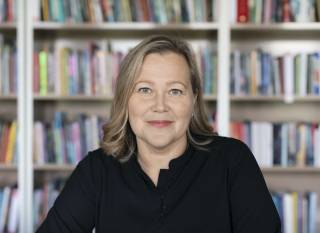Keynote speakers
Thursday 12.5.2022 at 11:00-11:45 Professor Mari Hatavara, Tampere University.
Friday 13.5.2022 at 12:15-13:00 Professor Elina Druker, Stockholm University.
Friday 13.5.2022 at 13:00-13:45 Docent Olli Löytty, University of Turku.
Presentation: Elina Druker

Elina Druker is Professor of Comparative Literature with specialization in children’s literature at Stockholm University. Her research area covers children’s literature, avant-garde and intermedia studies. She has published and edited several publications dealing with picturebooks and illustration history, modernism and the avant-garde and is author of Images of Modernism (2008) and co-editor for Children’s Literature and the Avant-Garde (2015) and Multicultural Children’s Literature (2017). She is currently working with the international project “Photography in Children’s literature” (forthcoming, 2023). Druker has worked as a literary critic, is jury member for the Astrid Lindgren Memorial Award, ALMA, and co-editor for the book series ”Children’s Literature, Culture and Cognition”.
Abstract of key note lecture: Utopian visions of a modern existence. Literary representations of children and modernity.
Depictions of modernist art, architecture and technical innovation in literature, culture and advertising in the beginning of the 20th century can be seen as a means of equipping citizens in different classes and age groups with knowledge of a quickly changing world. The ambition to educate individuals to become “modern” citizens and consumers, better functioning, healthier and happier members of society, was expressed not only in literature and art, but also through various program declarations, evening classes and guidebooks. By analysing three selected examples of Nordic literature with accompanied toys or artefacts, from the 1920s, 1930s and 1940s, I will discuss what kind of symbolic meaning children and children’s play are given in a modernist context and what kind of historically-located practices and activities are evoked. Applying a broad understanding of the concept of literature, I will discuss how interaction of texts and artefacts, can be understood and studied in a wider cultural context.
Both texts and artefacts consist not only of their material form, but of an intricate network of social and cultural scripts that invite certain historically constructed uses and performances of these things. By postulating how actual children use texts and materials provided for them, I recognize the relationship between real children and constructions of children. Applying theories from consumer studies and childhood research as well as research on modernity and children’s literature, I will discuss how selected literary texts from this era express ideas about modernism and modernity. The studied material encapsulates radical ideas of change and development and, consequently, demonstrates utopian visions of a modern existence. It exhibits an interdisciplinary convergence between material culture, commercialism and modernism, raising questions about the social and historic significance of literary studies. Therefore, it is relevant to discuss how a broader understanding of the concept of text and literature, and a possibly changed perception of literature as a research area, affects our understanding and methods of literature research.
